The following should not be tagged
- Bhāradvāja: This is a clan name
- Gotama should not be tagged as it is also a clan name and can refer to anyone from that family.
The following should not be tagged
To understand the topic taxonomy and terms, you may want to start with the Site Structure document.
In general, topic terms should only be added when the sutta really covers the topic term. If the word simply appears in the sutta, this is not enough to add it as a term.
If a topic taxonomy term has more than 20 suttas, it starts to become less useful to the reader. Therefore, we need to pay close attention when we consider assigning “hot topics” to suttas.
 For these hot topics, the sutta really needs to give specific, important information about the topic.
For these hot topics, the sutta really needs to give specific, important information about the topic.
| anger | Use if the sutta explains causes, problems of, or ways to remove anger |
| confidence | |
| desire | |
| Dhamma | Should talk about the qualities of the Dhamma |
| Four Noble Truths | |
| giving | Should give details of benefits or specific results of giving. Prioritize unique information. |
| greed | |
| happiness | |
| hatred | |
| jhana | |
| loving kindness | |
| meditation | Consider using more specific tags like mindfulness of death, impermanent meditation, etc. |
| merit | |
| mind | |
| monks | |
| Nibbāna | |
| Noble Eightfold Path | |
| parents | |
| precepts | Consider a more specific term such as five precepts, eight precepts |
| results of bad actions | |
| results of good actions | |
| saṁsara | |
| sense pleasures | |
| sharing merit | |
| stream entrant | |
| suffering | |
| the power of merit | |
| virtue | |
| wisdom |
NOTE: Items with a * can be done by any volunteer. The other items will probably need to be done by one of the monks, but suggestions are welcome.
It’s very important that title conform to a standard. It should be
{abbreviation} {number} {Pali title} Sutta: {English title} {optional number of repetiton}
If there are several suttas in a row with the same name, just put a number after the name without parentheses or st/nd/rd/etc.
When uploading suttas in bulk, we can add all the special information easily in our word processor.
Past this immediately after the title of each sutta:
#intro #topics #similes #names #furtherReading #explanation #questionForReflection
Then you can add any relevant information. For example:
#intro We can understand the Four Noble Truths if we have concentration. #topics concentration, Four Noble Truths, happiness #similes mountain #names Sariputta Arahant #furtherReading * See also SN 56.11 #explanation #questionForReflection What do you think it's like to live this way?
NOTE: If you are not familiar with our tags, you can see a list of all tags:
NOTE: Topics, People and similes are case sensitive! So Meditation and meditation will be two different topics.
Special note for people tags: For all monks and nuns who became Arahants, please put the personal name first followed by “Arahant”. For example: Sāriputta Arahant.
For other people like kings and queens. put their personal name first then king or queen. WHY? Because then they are all listed alphabetically by name. Also, see these guidelines.
Intros are a sentence that will draw someone into reading the sutta. Sometimes they are a question that the sutta will answer. Sometimes they say briefly what the sutta is about. Some can start with “The Supreme Buddha teaches about …” but they shouldn’t all start that way. Best thing is to look at the intros as they appear on any of the table of contents pages, for example, DN, MN, Khp, Ud, Itv, Snp, Vv, Pv.
For very short suttas it can be difficult to give an intro. Just create something and the bhantes will check.
These are suttas that are related to the sutta you are preparing. Most suttas will not have a further reading section.
If the sutta for further reading actually exists on the website, you can add in the code like this:
<li><ul><a href="https:suttafriends.org/sn56.11">SN 56.11 Dhamma Cakkappavattana Sutta</a></ul></li>
and then it will look like this when imported:
Not all suttas need an explaination.
Most suttas won’t have any questions for reflection.

An excerpt is a line from the sutta that gives a good idea what the sutta is about. It should be short. When you find it, put it in [[[triple brackets]]]. Include punctuation.
If you can’t decide, then skip this step.
Each individual verse must be enclosed with % % symbols like this:

Make sure that the quotation marks are curving towards the text. Also make sure that triple dots are the real elipses character (…)
If you are working in Google Docs, then add the addon “Text Cleaner” in Google Docs. Then select the text to correct and click as follows:

In general, we want to avoid text in (parentheses). If the sentence can be read without the text in the parentheses, then please turn it into a footnote.
Simplly place, then put footnote tags around it:
This is the text of the sutta.[footnote]This is my footnote.[/footnote]
And it will end up looking like this:

And when they click on the number the footnote pops up:

Namo Buddhaya!
Start by going to the Simile Index page, suttafriends.org/simile-index/
Find a simile that has not been indexed.
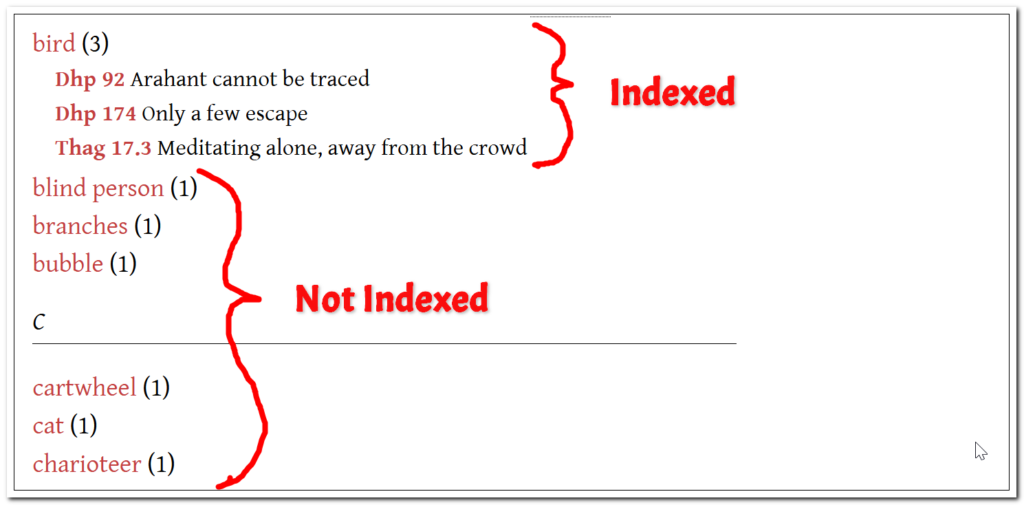
Click on the word to index:
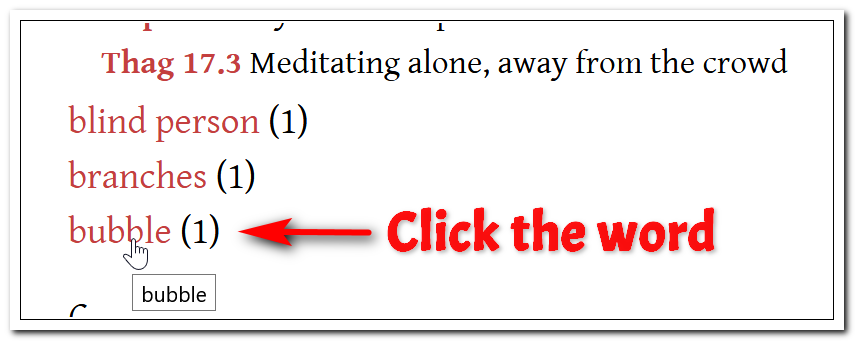
This will take you to what is called the archive page. For “bubble” the archive page url is suttafriends.org/simile/bubble/
This page will have the simile keyword at the top and a list of the suttas that have been tagged with it. In this case there is only one:

Click on the sutta opening it in a new tab.
Find the simile in that sutta
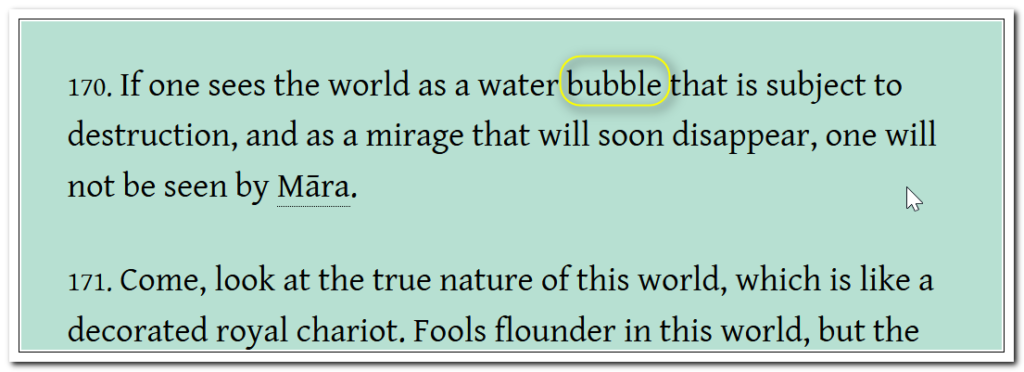
In this situation, it is the world that is being described by calling it like a bubble. The quality they both share is that they are subject to destruction.
First we need to write the citation. In this situation it is
Dhp v170
Then we need a description. For this, we have to mention the world and that it is unstable. Keep the descriptions short but meaningful. People should know what the simile is about by reading the description.
Dhp v170 The world is unstable
Next we have to find the link to the exact spot of the simile. For numbered verses it simple. We take the url for the page and add #v170 because it is verse 170.
suttafriends.org/sutta/dhp13/#v170
If there is no verse number, then an anchor has to be added to the page.
NOTE: The steps below can only be followed if you have editing access. If you don’t have that, then simply list
and send it to be reviewd and entered.
When you are logged into your account, click on “Edit Sutta” for the page you need to add an anchor to.
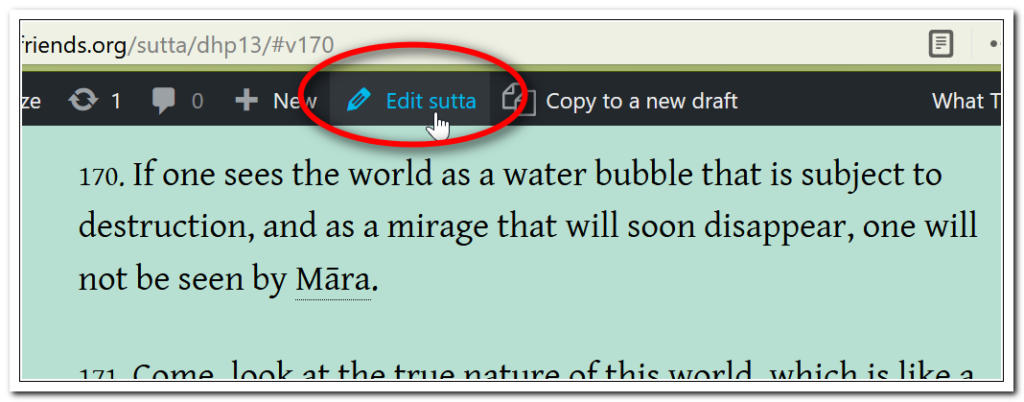
Once you are in the editor, find the paragraph you want to link to and click on the + button above it.
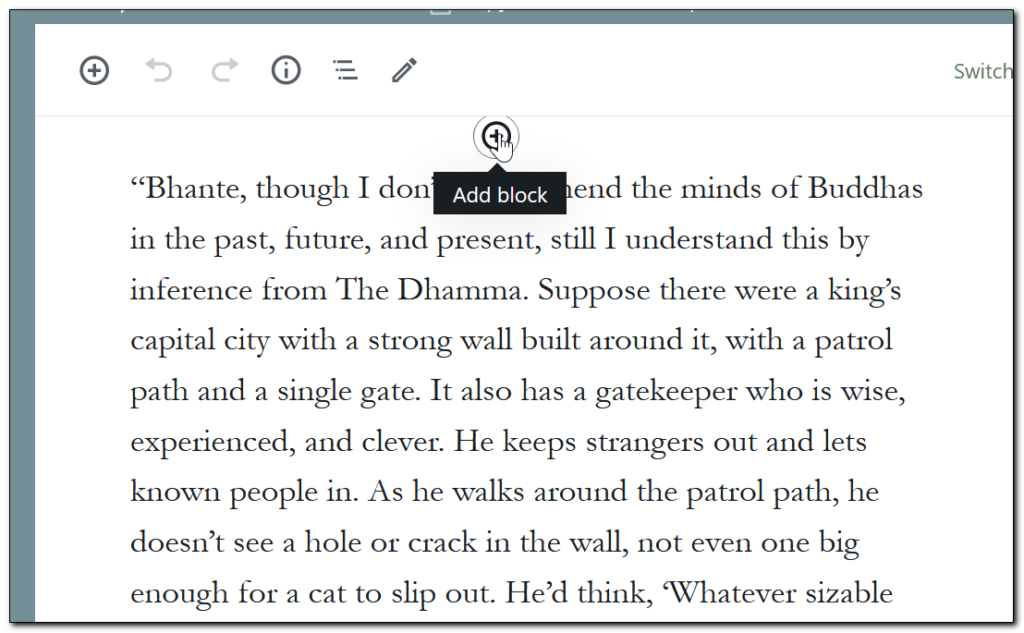
Then start to type the name of the anchor block in the search bar. Then pick the block.
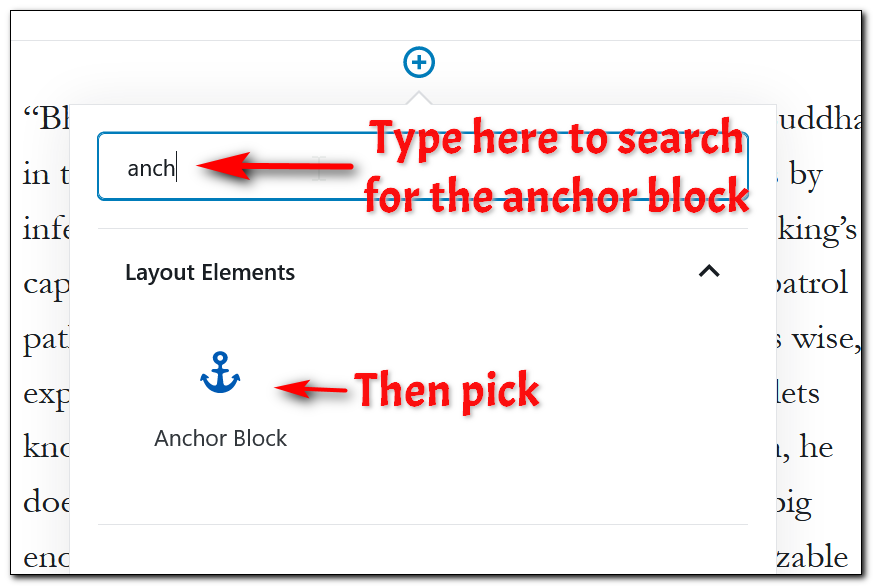
Then type in the name of the anchor. It should be the same as the index word for the simile. If it is a two word anchor, put a hyphen between the words.
If there are going to be more than one index item (in the example below we would also index for “gatekeeper”) only put one anchor and use for all.
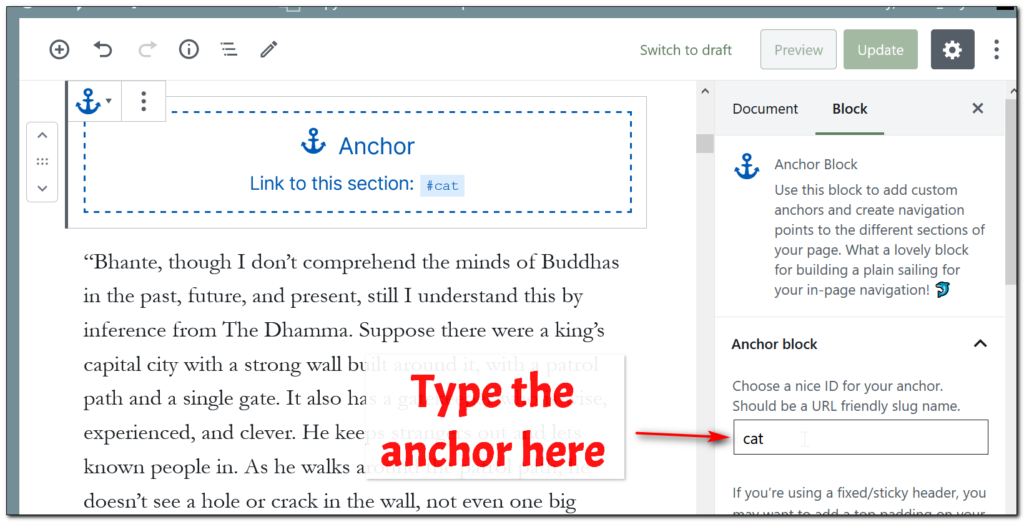
Then click Update.
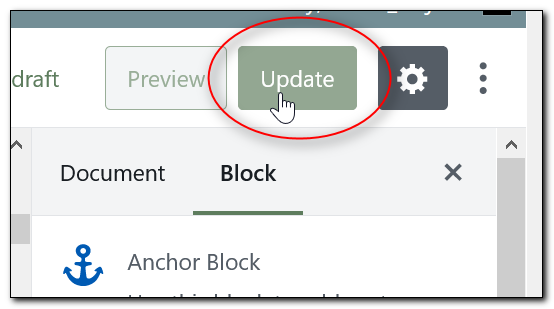
So the url for the cat simile in this sutta would be
suttafriends.org/sutta/dn28/#cat
Next we need to edit the tag itself. When you are on the archive page (in the bubble example the url is suttafriends.org/simile/bubble/) click
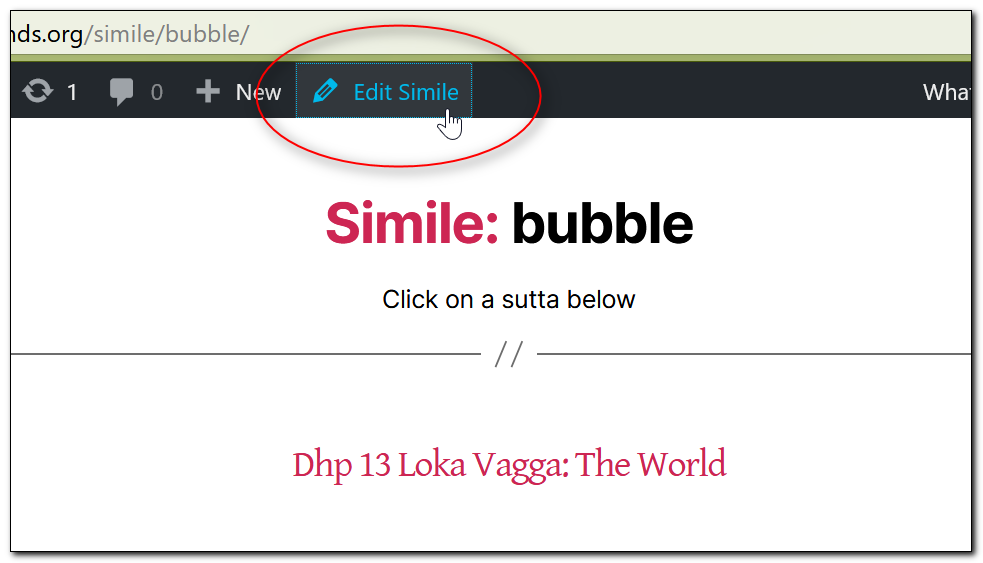
Now we will add the index item in the description of the simile tag. We style them as unordered lists.
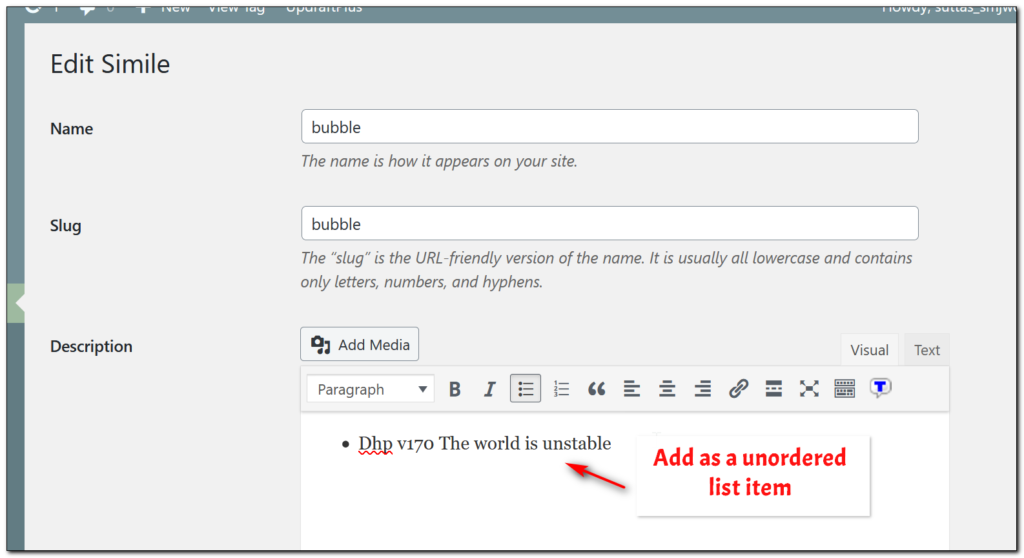
Then select the citation and click the add link icon

Then paste the link, making sure to use the anchor. Click “Apply.”

Then it will look like this:

When you click on a blank space, the citation will be blue and underlined.
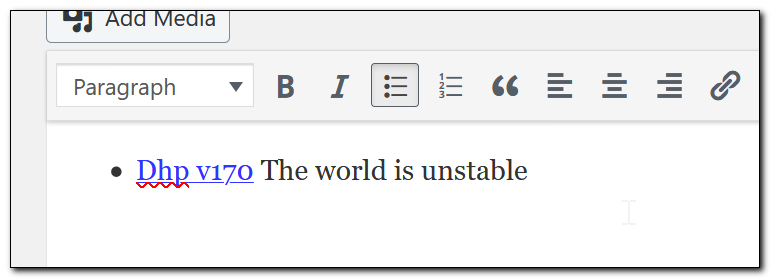
Then finally we have to click “Done” at the very bottom of the screen:
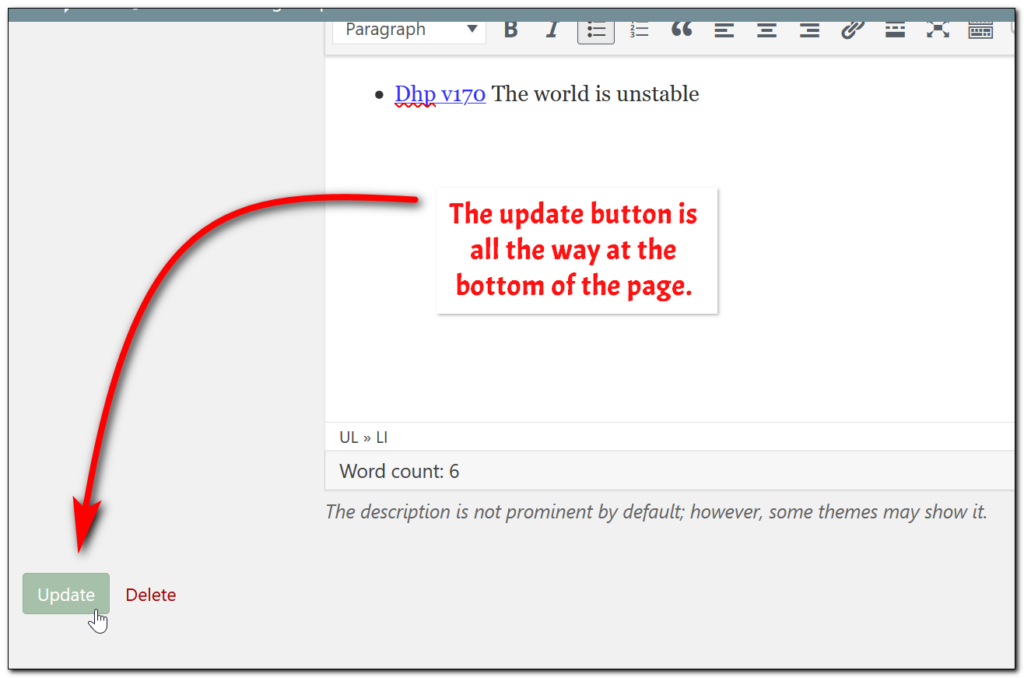
We are only indexing similes that illustrate a Dhamma point. For example, we will not tag or index these:
bamboo
https://suttafriends.org/sutta/pv1-11/
Our children are now very happy because they practiced generosity, but we are suffering like withered bamboo reeds.
bird call
https://suttafriends.org/sutta/dn30/
is as sweet as the bird kuraweeka’s call
https://suttafriends.org/sutta/thag21-1/
His voice is sweet like the sound of the myna bird.
The Therigatha verses of Arahant Ambapālī will not be indexed as similes because they are describing physical features, not Dhamma points.